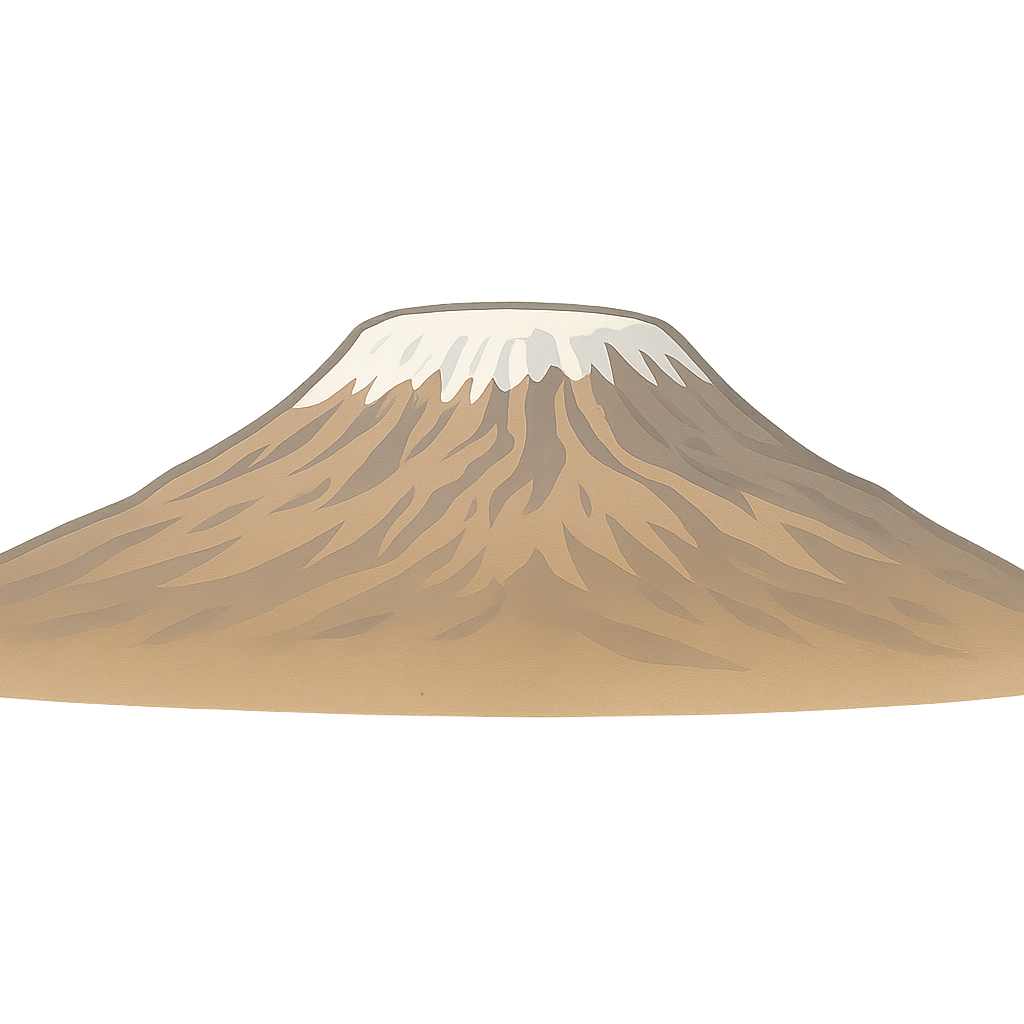The Voice of Kilimanjaro
I rise from the vast, sun-drenched plains of Africa, a solitary giant reaching for the sky. Below me, the savanna stretches out like a golden sea, dotted with acacia trees where giraffes and elephants roam. But as you climb my slopes, the world changes. You first enter a lush, green rainforest, alive with the chatter of monkeys and the flash of colorful birds. Higher still, the trees give way to misty moorlands with strange, giant plants that look like they belong on another planet. Keep climbing, and you will find yourself in a silent, rocky alpine desert, where only the hardiest life can survive. Finally, at my very top, lies a world of ice and snow. I wear a brilliant white crown of glaciers that sparkle under the equatorial sun, a sight so surprising that for many years, people from faraway lands refused to believe it was real. I am a world of contrasts, a mountain of many faces, a sacred place known as the Roof of Africa. I am Mount Kilimanjaro.
My story began not with stone and ice, but with fire and fury. I was born from the Earth’s powerful heart, a stratovolcano built layer by layer over hundreds of thousands of years. My creation was a dramatic dance of eruptions that formed my three great peaks. The first was Shira, who is now ancient and has collapsed into a rugged plateau. Then came Mawenzi, whose jagged, sharp peaks were carved by fire and ice into the dramatic form you see today. My youngest and tallest child is Kibo, a perfect, gentle cone that holds my highest point. For a long time, I rumbled and steamed, but now I am what scientists call dormant, which means I am sleeping. My fiery heart is quiet, but my spirit is very much alive. For centuries, my fertile slopes, nourished by volcanic soil and watered by glacial streams, have been a haven for life. The Chagga people made their home here long ago, developing brilliant farming systems of terraced gardens called 'kihamba'. They grew bananas, coffee, and other crops, and their lives became deeply intertwined with mine. In their stories, I am a sacred being, a source of life-giving water and a watchful guardian over their world.
For most of my long life, only the whispers of the wind and the footsteps of the local people knew my paths. But then, new voices began to travel on the breeze. In 1848, a German missionary named Johannes Rebmann saw my snowy cap from afar and sent word back to Europe. His reports were met with disbelief. A snow-covered mountain on the equator? Impossible, they said. Yet, the idea of me captured their imagination, and soon, explorers felt my pull. Many tried to reach my summit, but my icy heights and thin air turned them back. It wasn't until 1889 that a determined team finally stood on my highest point. A German geographer, Hans Meyer, and an Austrian mountaineer, Ludwig Purtscheller, made the journey. But their success would have been impossible without their guide, a young Chagga man named Yohani Kinyala Lauwo. He was only eighteen, but he knew my secrets—the safest paths, the best places to rest, and how to read my moods. On October 6, 1889, after several attempts, the three of them stood together on Kibo's crater rim, a powerful moment of persistence, courage, and collaboration between people from different worlds.
That moment was just one chapter in my continuing story. A new and powerful chapter was written on December 9, 1961. On that day, the nation of Tanganyika, now Tanzania, celebrated its independence. To mark this incredible moment of freedom, a soldier named Alexander Nyirenda carried a torch to my summit and lit it, a brilliant flame of hope visible for miles around. In honor of this event, my highest point was renamed Uhuru Peak. 'Uhuru' is the Swahili word for 'Freedom'. I became a symbol not just of natural wonder, but of human liberty and self-determination. Today, I am known as one of the world's Seven Summits, and people from every corner of the globe come to walk my paths. They come to challenge themselves, to witness my beauty, and to stand on the roof of their continent. But my story also carries a gentle warning. My ancient glaciers, my crown of ice, are shrinking because of our changing climate. They remind us that even the strongest among us are fragile. I hope that when people climb my slopes, they feel inspired—not just to conquer a peak, but to connect with nature, to overcome their own challenges, and to work together to protect this beautiful, precious world we all share.
Reading Comprehension Questions
Click to see answer
